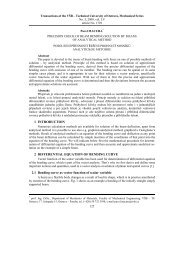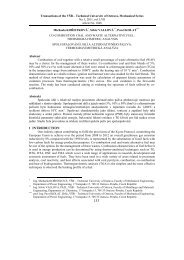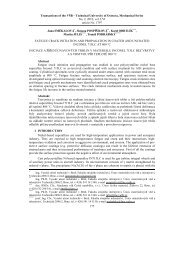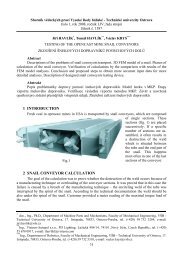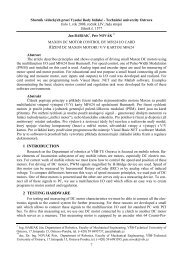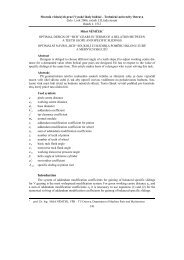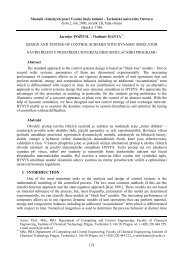SbornÃk vÄdeckých pracà Vysoké Å¡koly báÅské ... - Transactions
SbornÃk vÄdeckých pracà Vysoké Å¡koly báÅské ... - Transactions
SbornÃk vÄdeckých pracà Vysoké Å¡koly báÅské ... - Transactions
You also want an ePaper? Increase the reach of your titles
YUMPU automatically turns print PDFs into web optimized ePapers that Google loves.
feedback design. Next, we concentrate on the stability consequences of the small uncertain delays<br />
appearing in the state derivative feedback loop.<br />
3 INTRODUCTION TO STATE DERIVATIVE FEEDBACK<br />
Let us consider a system of the form<br />
where is the state and are the inputs. It is assumed that is of full rank, i.e. the<br />
system is state controllable and has no root at origin of the complex plane [1]. It is desired to design a<br />
stabilising controller of the form<br />
The closed loop system then takes the form<br />
The design problem is to compute a feedback gain matrix such that the closed loop poles<br />
are located in the open left half complex plane. This is achieved through a system transformation to<br />
the Frobenius canonical form and by applying a technique similar to that applied in the derivation of<br />
the Ackermann formula for state feedback. For derivations of the Ackermann formula for state<br />
feedback and the equation for state derivative feedback the reader is referred to [9] and [12]<br />
respectively. The formula derived in [12] can be generalised, using work presented in [5] to compute<br />
state derivative feedback gains for MIMO systems.<br />
It is important to note that a relationship can be derived between state feedback and state<br />
derivative feedback. From [1], the following relationship can be derived<br />
So the following relationship can be stated<br />
This is an interesting result considering the fact that algorithms for calculating state feedback gains<br />
are widely available in software packages such as MATLAB [4]. This relationship is used to obtain<br />
the results presented in this work, unless otherwise stated. Obviously, under the condition stated in<br />
the beginning of this section, the dynamics of the system can be assigned by (3) as if the classical<br />
state feedback is used. However, as will be shown in the next section, the state derivative feedback<br />
system (4) can be critically fragile w.r.t. small delays in the feedback loop.<br />
4 THE EFFECT OF SMALL DELAYS IN STATE DERIVATIVE FEEDBACK<br />
In real systems, it is inevitable that small uncertain time delays may occur in the feedback loop<br />
of an applied control algorithm. Recalling equation (1), and rewriting the equation considering such<br />
delays, we obtain the system in the form<br />
(2)<br />
(3)<br />
(4)<br />
(5)<br />
(6)<br />
(7)<br />
where are the delays arising in the feedback loop of the system. The summation over the input<br />
terms is necessary, due to the fact that each individual input may have a corresponding unique delay<br />
value. Now considering the state derivative feedback (3) (for simplicity, we use the notation<br />
), the closed loop system changes from the form (4) to<br />
57




